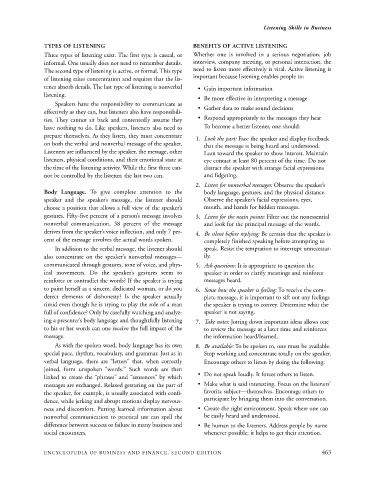Page 486 - Encyclopedia of Business and Finance
P. 486
eobf_L 7/5/06 3:14 PM Page 463
Listening Skills in Business
TYPES OF LISTENING BENEFITS OF ACTIVE LISTENING
Three types of listening exist. The first type is casual, or Whether one is involved in a serious negotiation, job
informal. One usually does not need to remember details. interview, company meeting, or personal interaction, the
The second type of listening is active, or formal. This type need to listen more effectively is vital. Active listening is
important because listening enables people to:
of listening takes concentration and requires that the lis-
tener absorb details. The last type of listening is nonverbal • Gain important information
listening.
• Be more effective in interpreting a message
Speakers have the responsibility to communicate as
effectively as they can, but listeners also have responsibili- • Gather data to make sound decisions
ties. They cannot sit back and contentedly assume they • Respond appropriately to the messages they hear
have nothing to do. Like speakers, listeners also need to To become a better listener, one should:
prepare themselves. As they listen, they must concentrate
1. Look the part: Face the speaker and display feedback
on both the verbal and nonverbal message of the speaker.
that the message is being heard and understood.
Listeners are influenced by the speaker, the message, other Lean toward the speaker to show interest. Maintain
listeners, physical conditions, and their emotional state at eye contact at least 80 percent of the time. Do not
the time of the listening activity. While the first three can- distract the speaker with strange facial expressions
not be controlled by the listener, the last two can. and fidgeting.
2. Listen for nonverbal messages: Observe the speaker’s
Body Language. To give complete attention to the body language, gestures, and the physical distance.
speaker and the speaker’s message, the listener should Observe the speaker’s facial expressions, eyes,
choose a position that allows a full view of the speaker’s mouth, and hands for hidden messages.
gestures. Fifty-five percent of a person’s message involves 3. Listen for the main points: Filter out the nonessential
nonverbal communication, 38 percent of the message and look for the principal message of the words.
derives from the speaker’s voice inflection, and only 7 per-
4. Be silent before replying: Be certain that the speaker is
cent of the message involves the actual words spoken. completely finished speaking before attempting to
In addition to the verbal message, the listener should speak. Resist the temptation to interrupt unnecessar-
also concentrate on the speaker’s nonverbal messages— ily.
communicated through gestures, tone of voice, and phys- 5. Ask questions: It is appropriate to question the
ical movements. Do the speaker’s gestures seem to speaker in order to clarify meanings and reinforce
reinforce or contradict the words? If the speaker is trying messages heard.
to paint herself as a sincere, dedicated woman, or do you 6. Sense how the speaker is feeling: To receive the com-
detect elements of dishonesty? Is the speaker actually plete message, it is important to sift out any feelings
timid even though he is trying to play the role of a man the speaker is trying to convey. Determine what the
full of confidence? Only by carefully watching and analyz- speaker is not saying.
ing a presenter’s body language and thoughtfully listening 7. Take notes: Jotting down important ideas allows one
to his or her words can one receive the full impact of the to review the message at a later time and reinforces
message. the information heard/learned.
As with the spoken word, body language has its own 8. Be available: To be spoken to, one must be available.
special pace, rhythm, vocabulary, and grammar. Just as in Stop working and concentrate totally on the speaker.
verbal language, there are “letters” that, when correctly Encourage others to listen by doing the following:
joined, form unspoken “words.” Such words are then
• Do not speak loudly. It forces others to listen.
linked to create the “phrases” and “sentences” by which
messages are exchanged. Relaxed gesturing on the part of • Make what is said interesting. Focus on the listeners’
the speaker, for example, is usually associated with confi- favorite subject—themselves. Encourage others to
dence, while jerking and abrupt motions display nervous- participate by bringing them into the conversation.
ness and discomfort. Putting learned information about • Create the right environment. Speak where one can
nonverbal communication to practical use can spell the be easily heard and understood.
difference between success or failure in many business and • Be human to the listeners. Address people by name
social encounters. whenever possible; it helps to get their attention.
ENCYCLOPEDIA OF BUSINESS AND FINANCE, SECOND EDITION 463

